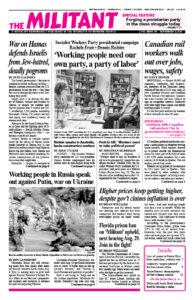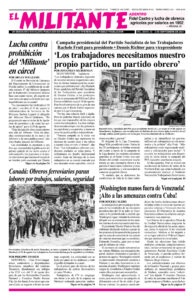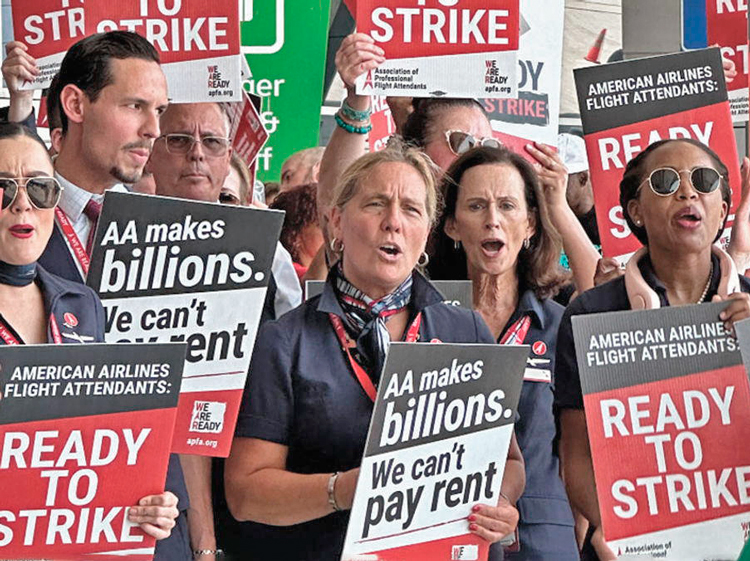“Every class struggle is a political struggle.” With that statement Jack Barnes, national secretary of the Socialist Workers Party, opened his report to an International Socialist Educational Conference in Oberlin, Ohio. “That’s a reality more and more workers in the United States are bumping up against in their own lives and battles today.”
Barnes was quoting an 1895 tribute by communist leader V.I. Lenin to Frederick Engels, who along with Karl Marx founded and led the modern revolutionary workers movement. In October 1917, after the horrors of more than three years of imperialist war, the Bolshevik Party, under Lenin’s leadership, led the working class and exploited peasants in Russia to the conquest of power and establishment of the first workers state in history. It was the world’s first victorious socialist revolution.
Lenin’s proletarian internationalist course, Barnes said, provides the Marxist foundation of all the SWP’s mass work. “The more such activity we’re engaged in together with other workers and exploited producers,” he said, “the more we draw on and use our communist political continuity, our program, the experiences of our party history.”
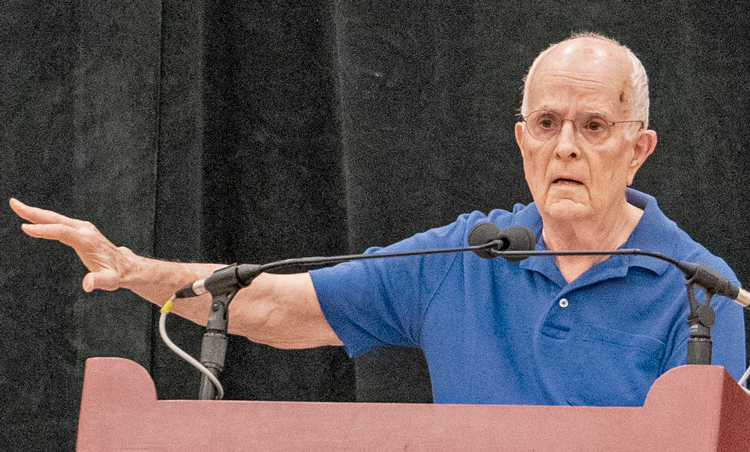
Some 330 participants attended the June 13-15 conference. Among them were members of the SWP in the U.S. and Communist Leagues in Australia, Canada and the United Kingdom, along with party supporters and invited guests from those countries as well as France, Greece, Iceland, and Norway.
Marx and Engels were the first to show that the working class — as well as the social and political demands workers fight for — are a product of the capitalist system, which “creates and organizes the proletariat,” Lenin said in his 1895 article. It is the only class with the social power, organization, and experience in common struggle to effectively combat the bosses, their political parties and their state. The only class with no stake in exploitation and oppression of any kind, and with a class interest in workers developing the confidence, capacity and political consciousness to fight capitalist rule and win.
The bigger the working class, Lenin said, “the greater is their strength as a revolutionary class, and the nearer and more possible does socialism become.” Above all, Lenin said, Marx and Engels taught this new class “to know itself and be conscious of itself” — to be politically conscious of “acting as an independent social force.”
That remains true to this day, Barnes emphasized, calling attention to the banner hanging at the front of the conference hall: “For a political break from the bosses’ parties. For a party of labor. Build the Socialist Workers Presidential Campaign.”
His report politically armed and oriented participants with the SWP’s program and line to forge a revolutionary proletarian party whose members and branches are actively engaged in the class struggle in the U.S. and worldwide.
In addition to Barnes’ report, there were plenary presentations by party leaders Dave Prince and Mary-Alice Waters, as well as classes and an event the closing night addressed by the Socialist Workers Party’s 2024 presidential campaign ticket: Rachele Fruit for president and Dennis Richter for vice president.
Low point of resistance behind us
The low point of working-class and labor resistance in the United States is behind us. That was a central political conclusion of the Socialist Workers Party’s December 2022 convention, Barnes said. After a retreat in struggles by workers and the oppressed for several decades, recent years have seen a renewal of fights and solidarity activity. Party members have been an integral part of this resistance in the unions and more broadly, alongside co-workers and fellow unionists.
Over the past half decade, workers in the U.S. — railroad workers, aerospace workers, truck drivers and warehouse employees, port workers, nurses, autoworkers, car service drivers, flight attendants, farmworkers, workers in factories, mines, and mills, large and small — have organized strikes and other fights in face of intensifying pressures from the employers. They’ve taken part in united actions and social protests in the interests of the working class and oppressed.
These take place as the capitalist rulers have stepped up attacks on working people. Starting a family and providing for it has become more and more difficult for workers — women and men, of all skin colors and nations of origin, in big cities, small towns and rural areas. Workers are resisting declining real wages, rising prices, speedup, work schedules that damage health and families, cuts in the size of train crews, bouts of joblessness and shrinking openings for employment. Workers pay with their lives for defective, unsafe machinery and equipment — on the job and in communities like East Palestine, Ohio, hit by devastating “accidents.”
These conditions in the working class bear down with even greater weight on the oppressed Black nationality. Living standards for the big majority of African Americans get worse, even as the size of privileged middle-class and professional layers expands. Given Blacks’ large numbers and centurieslong history in the U.S., the national question of African Americans is a decisive one in the U.S. class struggle, the SWP leader said. Just look at “the vanguard place and weight of workers who are Black in broad proletarian-led social and political struggles in the United States,” Barnes pointed out in his book Malcolm X, Black Liberation, and the Road to Workers Power.
Growing numbers of immigrant workers face miserable living and job conditions, cynically played on by the employing class and the Democratic and Republican parties that represent them. The capitalists loosen or tighten flows to meet their demand for low-wage labor, squeezing profits from the pariah status of these workers and intensifying competition and divisions in the working class.
Progress by women who were drawn into the workforce in growing numbers for several decades during and after World War II — including into jobs previously held only by men — began leveling off a quarter century ago. Faced with sharply rising costs of child care, schooling, groceries, rent and mortgage payments and other needs, it is women who shoulder the heaviest burden of conflicting pressures on their families. Get a job to bring in more income? Or leave the workforce to reduce expenses for child care?
Using our unions to resist
As workers, organized and unorganized, look for ways to resist, Barnes said, union members are finding ways to use these basic organizations of our class to defend wages and conditions and to mobilize solidarity with others engaged in fights with the bosses. Among those who are not union members, still the great majority, more are becoming open to joining a union or organizing along with other workers to win union recognition and a contract.
Workers are learning to work together through the unions in order to strengthen them, earning mutual respect and trust for their discipline as fighters. At an SWP leadership meeting a few weeks after the conference, Barnes recalled a discussion with a party member who, as part of his communist political activity over decades, has done effective work in his union organizing strike solidarity with workers across the country. In his various industrial jobs and unions, he told Barnes, he has held to two guidelines:
First, always work safe, no matter the pressure the bosses bring down on you and your co-workers. Second, don’t act on your own or “pop off” to managers or supervisors in anger or frustration. Drawing a spotlight on yourself makes it more difficult to organize the collective strength of the union and fight together effectively. It gives the company an arbitrary handle to weaken the union and victimize or fire you and other workers.
Barnes pointed to another important guideline in his conference report, one especially decisive as opportunities for mass work begin opening up. Ultraleft temptations, he said, can be our biggest obstacle: the impulse “to make opportunities happen,” rather than responding to openings and acting on them together with other workers.
Organizing resistance and solidarity takes not only consciousness and determination, Barnes said, but time and resources as well. Workers need to travel to bring solidarity to strikes elsewhere in the country and to take part in local, regional and national meetings and activities of their unions and the labor movement.
Individual workers and their families can’t take upon themselves all these costs and possible penalties for lost time. That’s what paid union time off is all about: to lift such obstacles and strengthen union activity. Union resources can be used effectively to build the labor movement, including organizing the unorganized.
The 2022 SWP convention, Barnes said, increased the party’s readiness to make the most of the “breeze at our backs” being felt by workers starting to fight. Among other steps, delegates reinforced the multiple generations of worker-bolsheviks represented on the party’s National Committee by electing several more cadres who’ve proved themselves in the party’s mass work.
No end to capitalist world disorder
At the opening of the 1990s, with the collapse of Stalinist regimes in the Soviet Union and across Central and Eastern Europe, there was a burst of triumphalism among the ruling classes of the U.S. and other imperialist powers. Capitalism and “democracy” — democratic imperialism — would now reign supreme. It was “The End of History,” in the words of a global best seller.
This brief jubilation was reinforced in early 1991, when a Washington-organized military coalition quickly and brutally defeated the Iraqi regime of Saddam Hussein in Iraq, which had invaded and occupied neighboring Kuwait. This “victory” came at the cost of the lives of tens of thousands of Iraqi, Kuwaiti, Kurdish and other soldiers and civilians.
The Socialist Workers Party said, “No!” U.S. imperialism has lost the Cold War, not won it. The fall of the Stalinist apparatuses eliminated a class-collaborationist crutch the imperialist rulers had relied on for more than six decades to undermine national and class battles the world over and block extension of the socialist revolution.
As for Washington’s murderous “victory” in the first Gulf War, the outcome did not foster peace in the Middle East or anywhere else, said the SWP. It marked the “opening guns of World War III.”
As Lenin had polemicized in response to class-collaborationist opponents in the socialist movement during World War I, in the imperialist epoch rival national ruling classes no longer offer any road forward for humanity. The rival imperialist powers resort to trade conflicts and wars to redivide the world, in order to maximize profits by exploiting hundreds of millions of workers and other toilers in every corner of the earth.
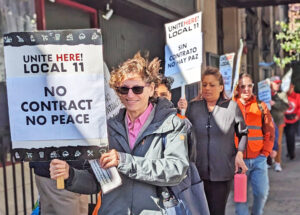
Today imperialist crises are proliferating — wars and prospects of more wars; global breakdowns of production, finance, trade, and “supply chains”; economic and military rivalries among bourgeois governments and ruling classes. While voices in capitalist politics spout self-serving rationalizations about restoring “global stability,” others are more frank. In his conference report, Barnes pointed to the example of Richard Haass.
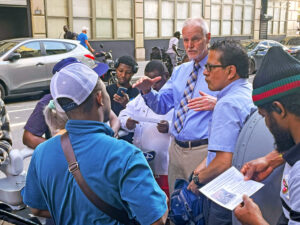
Under two White House administrations between 1989 and 2003, Haass had been a top foreign policy adviser and evangelist of both the first (1990) and second (2003) Gulf Wars. Then, for two decades, he was president of the U.S. ruling-class institution, the Council on Foreign Relations. By late in those years, Haass’ earlier bravado had been deflated. A World in Disarray was the title he gave a 2017 book. Asked last year by the Wall Street Journal what he might entitle a sequel today, Haass answered: Disarray on Stilts.
Meanwhile, despite their climate doomsaying and alarms over a “resurgent far right” in the U.S. and Europe, the middle-class left, including Stalinist currents in Maoist or other garb, promote their own myths of global “stability.” As they say in their classless jargon, “we” need a more peaceful “multipolar world.”
Many of them put their money especially on the governments of the People’s Republic of China, the Russian Federation, and to a growing extent the Islamic Republic of Iran. They look to “the Global South,” the “BRICS” (a loosely tied “bloc” of Brazil, Russia, India, China, South Africa and others), and Tehran’s “axis of resistance” — conglomerations of capitalist governments and armed militias that petty-bourgeois radicals pretend are a “counterweight” to U.S. imperialism.
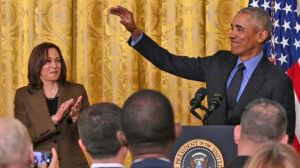
Growing numbers of workers in the United States, however, sense from our own lives and experience that no capitalist government or political party, anywhere in the world, has solutions to the wars and breakdowns threatening humanity. These crises are produced by the workings of capitalism, not ameliorated by imperialist governments or bourgeois alliances.

The Socialist Workers Party, Barnes said, has pointed to this developing world imperialist crisis for decades and explained its inevitable consequences. Above all, the SWP patiently explains a revolutionary working-class program and course of action: what working people can do to combat imperialism’s relentless march toward fascism and world war, a deadly march that in the 20th century and opening years of the 21st has cost the lives of hundreds of millions.
“We explain and act on the working-class line of march toward workers power and a socialist world,” Barnes said.
The titles alone of resolutions, articles, and books by Jack Barnes and other SWP leaders in recent decades offer a guide to such a working-class alternative: “US Imperialism Has Lost the Cold War,” “Capitalism’s World Disorder,” “The Opening Guns of World War III,” “Capitalism’s Long Hot Winter Has Begun,” “Malcolm X, Black Liberation, and the Road to Workers Power,” “The Clintons’ Anti-Working-Class Record,” “Are They Rich Because They’re Smart? Class, Privilege, and Learning under Capitalism,” “The Turn to Industry: Forging a Proletarian Party.” And — most recently — “The Low Point of Labor Resistance Is Behind Us” and “The Fight Against Jew-Hatred and Pogroms in the Imperialist Epoch: Stakes for the International Working Class.”
There have been two great socialist revolutions in the past century, Barnes said. The first was the Bolshevik Revolution led by Lenin in 1917. The other was Cuba’s socialist revolution, brought to victory under the leadership of Fidel Castro at the opening of the 1960s.
“As Cuban toilers reached out to be led,” Barnes said, “Fidel listened and showed, both in word and deed, that he and others in the leadership of that revolution would respond by organizing working people to fight for and win their own demands.
“The communist leadership forged by Fidel won the confidence of millions of workers and peasants, who were convinced — as they were organized and led in revolutionary struggle — that this was their revolution to make. It was their socialist revolution.
“That’s the only test that counts for a revolutionary leadership, a proletarian leadership,” Barnes said. It’s the only road that makes a socialist revolution possible. And it changed the course of history and the class struggle ever since.
Building a party of labor
The working class in the United States needs to break from the Democratic, Republican and other capitalist parties and candidates, Barnes said. “Through experience in struggle, we need to forge our own political party, a party of labor, based on the trade unions and organizing to lead the working class as a whole, as well as other exploited and oppressed producers and nationalities.
“We’re not talking about an electoral machine,” Barnes emphasized. “Although a party of labor will run candidates in elections for federal, state and local offices against the bosses’ representatives and campaign for a working-class program.
“Workers and our allies need a party of independent working-class political action — class against class — in factories and other workplaces, in army barracks, and in the neighborhoods, towns and streets where working people live and labor.”
This is at the center of what the SWP presidential ticket of Rachele Fruit and Dennis Richter are explaining using the arena of the 2024 elections.
The energies and resources of workers and the unions shouldn’t be diverted into financing and “getting out the vote” for candidates who speak and act on behalf of the capitalists and their legislative schemes, whether fancied up as “labor friendly,” “job-creating,” or whatever. The unions need to act politically in their own right — in workplaces and the streets, not just at the ballot box — in order to fight effectively and maintain workers’ hard-won gains.
There is no all-encompassing “we” in capitalist society and politics, Barnes said. On one side, there are the ruling capitalist families and a large professional and upper-middle-class layer who serve and rationalize the ruling families’ profit system. On the other are the vast majority of workers, other exploited producers, and small rural and urban proprietors. The class interests of the two sides irrepressibly conflict; they are polar opposites.
Socialist Workers Party members explain this pressing need for a class break to other workers — at doorsteps, on picket lines, at work and elsewhere — as we point out why we encourage them to endorse the 2024 SWP ticket of Fruit and Richter. The interest we’re finding in prospects for a party of labor, Barnes said, is registered, among other ways, by those who want to take a stand, sign an endorser card, and find out more about the SWP’s revolutionary working-class program.
A labor party, Barnes said, would chart both a working-class domestic policy and a working-class foreign policy. It will approach workers and exploited producers in other countries as part of our class, not as enemies.
It will be a party that aims to take the power to make war, which always includes the threat of nuclear annihilation, out of the hands of the capitalist rulers.
One that ends for all time the U.S. imperialist rulers’ more-than-six-decades-long economic and military drive to destroy and erase Cuba’s socialist revolution.
That joins in the international fight against Jew-hatred and pogroms, from the Middle East to the U.S. and other countries the world over.
A party that champions the right of Ukrainians, Kurds, Palestinians, Puerto Ricans and other oppressed peoples to national self-determination.
A party that joins in the global struggle for national liberation and to establish workers states that cooperate in the battle to eradicate exploitation and oppression in all forms, along the road to a socialist world.
Malcolm X and workers power
There was one prominent leader of the U.S. class struggle in the latter 20th century, Barnes said, whose political trajectory converged with such a proletarian internationalist and independent working-class course. That was Malcolm X.
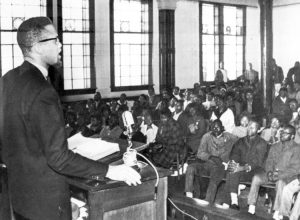
Through his political evolution the last year of his life, Malcolm became “the face and the authentic voice of the forces of the coming American revolution,” Barnes explains in Malcolm X, Black Liberation, and the Road to Workers Power. Malcolm was not only the outstanding leader of the oppressed Black nationality in the United States, but also a revolutionary leader of the working class. A leader of the exploited and oppressed the world over.
Malcolm X was won to this proletarian course, Barnes said, by advances in the world revolution and his own political attraction to them. As Malcolm told a large audience in February 1965, a few days before he was assassinated, “It is incorrect to classify the revolt of the Negro as simply a racial conflict of Black against white, or as a purely American problem.” Rather, he said, “We are today seeing a global rebellion of the oppressed against the oppressor, the exploited against the exploiter.”
Malcolm X rejected the class-collaborationist political perspectives of Martin Luther King and other top figures in the Black rights movement in the 1960s. Malcolm publicly rebuffed their call on Blacks, as well as opponents of Washington’s war against the Vietnamese people, to subordinate their struggles in the streets to the electoral needs of the imperialist parties.
Malcolm unmasked the Democratic Party’s claim to be anything other than one of the two U.S. parties of racism, capitalism and imperialist war. He answered the illusion, which the rulers promote widely among the oppressed, that the fight for Black liberation can be achieved under capitalism. Stop trying to escape the wolf by fleeing to the fox, he said; neither one is the “lesser evil.”
Barnes reminded conference participants that a decisive reason for Malcolm’s break with the Nation of Islam in early 1964 was his moral and political revulsion at Nation leader Elijah Muhammad’s sexual exploitation of young women. Malcolm’s increasingly outspoken championing of the importance of advancing women’s emancipation in the United States, Africa and elsewhere set an example for fighters the world over.
Reshaping ‘two-party system’
While capitalism’s instability and disorder have no end in sight, the related shakeup inside each of the two dominant imperialist parties is beginning to be stabilized. Shifts in both the Democratic and Republican parties — registered especially since the election of Barack Obama in 2008, and then Donald Trump in 2016 — are reshaping aspects of the capitalist two-party system. Both ruling-class parties are now in better shape in 2024, Barnes said.
The Obama administration, as Barnes explained in his 2016 book Are They Rich Because They’re Smart? Class, Privilege, and Learning Under Capitalism, signaled a move away from the Democratic Party’s self-proclaimed image as the party of the working class and unions. Those pretensions — opportunistically bolstered for decades by top union officials, the Stalinist Communist Party, Social Democrats and bourgeois liberals — go back to Franklin Roosevelt’s “New Deal” administrations during the Great Depression of the 1930s. The Democrats’ class objective, shared by their Republican rivals, was to rescue crisis-wracked U.S. capitalism by joining the second imperialist world slaughter and coming out on top of the heap — of both enemy and allied powers — militarily and economically.
Despite decadeslong efforts by top union officials to keep labor tightly bound to the Democrats, by the end of Obama’s two terms in 2016 his campaign pledge of “Change!” rang increasingly hollow to tens of millions of workers and their families, who’d borne the brunt of so much social devastation. Joseph Biden’s replacement this year by Kamala Harris as the Democrats’ presidential candidate has furthered the party’s makeover.
Both Harris and Obama are products of what Barnes described in his book Are They Rich Because They’re Smart? as “the explosive growth” of “a new stratum of bourgeois-minded professionals and middle-class individuals — of all colors and hues — in cities, suburbs, and university towns across the country.” A social layer interested, first and foremost, in advancing their own individual careers and monetary rewards.
Those who count themselves as part of this self-proclaimed “enlightened meritocracy,” Barnes wrote, “truly believe that their ‘brightness,’ their ‘quickness,’ their ‘contributions to public life’ … give them the right to make decisions, to administer and ‘regulate’ society for the bourgeoisie — on behalf of what they claim to be the interests of ‘the people.’”
The growing social and moral gap between the working class and this meritocracy is understood by more and more workers, including those who are Black.
When Joseph Biden was abruptly removed from the ballot by Democratic Party leaders on July 21, he dutifully deferred to Harris as his successor. Like South Carolina Rep. Jim Clyburn — who had salvaged the current president’s sagging 2020 bid midway during the primaries that year — Biden is a discarded vestige of Democratic machine politicians associated with the party’s New Deal social promises.
But it was Barack Obama’s videotaped phone call on July 26 — “It appears that people feel very strongly that you need to be our nominee” — when Harris was truly “anointed.” The crown prince of the meritocracy, himself no longer eligible for the throne, had settled the succession.
The same causes that resulted in millions of workers not voting for Hillary Clinton in 2016 also led many either to vote for Donald Trump that year or to stay away from the ballot box altogether. Trump, himself a wealthy New York real estate developer, demagogically pitched his campaign to workers and those in the worse-off middle classes, including substantial numbers who had voted for Obama in 2008 and 2012. Trump got an assist from Clinton’s declaration that at least “half” of those considering a vote for Trump were both “deplorables” and “irredeemable.”
Trump has tried to relegate to the sidelines the Republicans’ longtime image as a largely “business-oriented” party of low tariffs, immigration of “cheap labor,” “entitlement” foes, and bipartisan war-makers. Republicans, Trump says, are now the “real workers party,” determined to reverse the (very real) “carnage” facing working people in both industrial and rural areas. He has doubled down on that pitch in 2024, among other means, by choosing southern Ohio-born J.D. Vance as his running mate and by inviting the president of a major trade union, Sean O’Brien of the Teamsters, to address the Republican national convention in July.
Despite such strides toward stability in the two imperialist parties, and a shift in the particular “lesser evils” that each campaigns on, growing numbers of workers are questioning whether either party offers anything more to those who work for a living than added belt-tightening, sacrifice and wars.
High prices and families
Two of the biggest scourges for the working class and other toilers today, Barnes said, are rising prices, on the one hand, and the decline in steady work at livable wages, on the other. Both account for the mounting difficulty of workers’ families in meeting the costs of food, housing, medical care and other necessities.
The bosses, their government, and their mass media prattle about “controlling inflation,” or “cracking down on price gougers.” They mystify the class truth that rising prices are a necessary result of production for profit and capitalist government. They are a by-product of capitalist promises.
Liberals pledge to resolve the economic and social crises of their system through big government spending and budget deficits. Both bosses’ parties manipulate interest rates and “monetary policy,” and lavish enormous amounts on imperialism’s state bureaucracy and war spending.
Capitalist economic instability, Barnes told conference participants, is made worse, not “solved,” by vast government debt. These policies, the hallmark of Democratic Party liberals and their class-collaborationist backers in the labor movement, result in price hikes that are offloaded onto the working class and their families. These government policies, Barnes said, quoting the words of a Wall Street financial columnist, “willfully cheapen the purchasing power” of workers’ wages and “steal human heartbeats.”
Communist workers — through SWP election campaigns for a party of labor, through its press, and through its mass work — must answer bourgeois mystifications about “inflation,” “monetary policy,” and “fiscal policy,” Barnes said.
“We explain that the capitalist rulers, their government, and their parties are the cause of high prices. In order to combat the ruinous consequences for the exploited and oppressed in town and country, the unions need to fight for full cost-of-living escalators to protect both wages and government benefits such as Social Security and others.”
At the same time, in face of capitalism’s accompanying curse of unemployment, the working class and unions must fight for a shorter workweek, with no cut in pay. And for a massive, government-funded program of public works to provide jobs at union-scale wages building housing, schools, hospitals, child care centers, rural development and other things working people need.
Defend constitutional protections
“Defending and extending the freedoms protected by the US Constitution is at the center of the class struggle today,” says the opening sentence of the SWP’s 2022 political resolution. “Workers and farmers must organize and act to prevent the federal government’s assaults on these freedoms, which have been won in class battles over some two and a half centuries.”
That judgment is truer than ever some two years later, Barnes told conference participants. Democratic Party liberals at federal, state and local levels are pressing to silence, criminalize, prosecute and imprison their political opponents. The biggest immediate target is the Democrats’ challenger in the U.S. presidential election, Donald Trump — “a convicted felon,” they chant without end — as well as others whom liberals and middle-class radicals seek to tar with the same brush.
“Under conditions of the bourgeois regime,” Bolshevik leader Leon Trotsky reminded us in 1939, “all suppression of political rights and freedom, no matter whom they are directed against in the beginning, in the end inevitably bear down upon the working class, particularly its most advanced elements.
“That is a law of history.”
The Biden White House and “Justice” Department, along with their backers in city halls and state houses, have unleashed political police raids, handed down indictments and empowered unconstitutional “special prosecutors.” All this highlights the stakes for the working class, labor movement and all the oppressed in defending constitutional guardrails that protect us against the U.S. imperialist state.
The Constitution’s separation of powers between the White House, Congress, and the Supreme Court — an important protection for the working class — is now under fire by the Biden administration and other Democrats. The gunsight is focused first and foremost on the U.S. Supreme Court, with Biden floating proposals to revoke the Constitution’s lifetime appointment of justices and impose term limits. Rep. Alexandria Ocasio-Cortez has introduced articles of impeachment in Congress against two of the nine court justices.
In addition, there are expanding attacks on the Constitution’s first 10 amendments. Often called the Bill of Rights, they were won by toilers in the wake of the victorious First American Revolution, which defeated British colonial rule and established the world’s first modern republic.
Efforts are mounting to roll back First Amendment protections such as “the free exercise” of religion, and the freedom of speech, press and assembly. In recent years, these efforts are increasingly driven from the bourgeois and petty-bourgeois left. The First Amendment, say its vilifiers, is being “weaponized.” In plain words, Barnes said, they want to make it easier to “cancel” or “shut down” anyone who disagrees with their views on any question central to working-class struggle.
At the same time, he added, conference participants should welcome a May 2024 Supreme Court decision overruling efforts by the state of New York to gag support for the Second Amendment’s “right of the people to keep and bear arms.” First Amendment rights would be rendered defenseless against suppression, the SWP leader said, without the right to protect ourselves, our unions and other mass organizations from the capitalist rulers’ “legal” and “extralegal” violence.
The working-class vanguard has a life-and-death stake in also defending the three constitutional amendments won through the victory of the Second American Revolution — that is, the U.S. Civil War and postwar Radical Reconstruction.
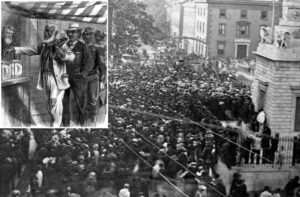
Those three — the 13th, 14th and 15th amendments — were more than simply additions to the Constitution. They changed the entire document — in ways that are of central importance to the toiling classes, Barnes said. The Constitution and Bill of Rights had largely guaranteed only freedoms and protections from the federal government, not from state or local governments. That included decisions concerning the institutions of chattel slavery and bonded labor, as well as the right and qualifications of U.S. citizens to vote, both previously reserved for individual states to determine and enforce.
That changed with the three “Reconstruction Amendments,” which ended slavery “within the United States,” or any place subject to its jurisdiction (13th); declared that no state shall deprive “any person within its jurisdiction the equal protection of the laws” (14th); and forbade states from denying any citizen voting rights “on account of race, color, or previous condition of servitude” (15th).
By codifying these hard-fought rights in a bourgeois constitution — one with the paramount aim of legitimizing and entrenching the dictatorship of capital — those amendments also accomplished something more, Barnes said. Whatever the authors’ intentions, those protections against the state serve a political and educational purpose — a purpose very useful to the working class.
“They help expose what class-divided society is all about,” Barnes said.
Hamas’ Nazi roots and imperialism
During summary presentations the final afternoon, Barnes talked about the book newly published by Pathfinder Press for communist workers to campaign with, The Fight Against Jew-Hatred and Pogroms in the Imperialist Epoch: Stakes for the International Working Class by communist leaders V.I. Lenin, Leon Trotsky, Farrell Dobbs, James P. Cannon, Dave Prince, and himself.
The front cover features two photographs that several party speakers focused attention on.
One is a 1943 photo of Nazi storm troopers rounding up Jewish children, women, and men in Warsaw, Poland, for deportation to the Treblinka death camp. Some 7,000 Jews had just been slaughtered in Warsaw, as the Nazis crushed a monthlong uprising in the city’s Jewish ghetto, the first major urban revolt in Europe against German imperialist occupation.
The other photo, taken inside Gaza on Oct. 7, 2023, is from a Hamas “bodycam” video of a young Jewish woman brutalized and taken hostage in Israel earlier the same day. That was the day of the single most murderous pogrom since World War II and the Holocaust.

Politically, Barnes said, that’s the only cover this book could have had. “The juxtaposition of the two photos tells the truth: that Hamas’ roots lie in the organization of the Nazi Holocaust. Jew-hatred wasn’t something Hamas tacked on to their reactionary program. It lies at the heart of who they are.” Like the Nazis, Hamas is a deadly enemy of Jews the world over, as well as all the exploited and oppressed, including Palestinians.
The cover reminds us that in the imperialist epoch the character and social weight of Jew-hatred changes. It becomes more virulent and develops a global reach; it’s an integral part of the social convulsions of imperialism.
In face of their own irresolvable crises, sections of the ruling classes seek to divert the anger of the insecure or ruined petty bourgeoisie, as well as small numbers of discouraged workers, away from capitalism as the source of their problems. The rulers point the finger at Jews, promoting Jew-hatred as the banner of international reaction.
They foster declassed lumpen gangs, unleashing thugs against Jews, assaulting other organizations of the oppressed, and mobilizing to destroy trade unions and communist organizations. The “traditional” bourgeois parties, the officer corps, the church hierarchy, businessmen, sections of the Nazi Party itself and many others are targeted. The overall aim is to divide and dehumanize — to make pariahs of sections of working people — thus demoralizing growing numbers of workers seeking to unite and lead a fight to establish working-class rule, as in Russia in 1917 and in Cuba at the opening of the 1960s.
The Jewish question is a national question that cannot be resolved under imperialism. Like other national questions brought to the fore by the death agony of capitalism, including the national aspirations of the Palestinians, it will be resolved only as working people of all religions and ethnic roots across the region join each other in revolutionary struggles to take state power and end capitalist rule.
“It’s incorrect to say Hamas’ roots lie in fascism, since not all fascists end up organizing a Final Solution,” Barnes said. “It was the Nazi Party and Hitler’s imperialist regime that — during the closing years of World War II — decided and carried out that massive effort to annihilate the Jewish people.”
Barnes described the wartime collaboration in Germany between the Nazis and Amin al-Husseini. Al-Husseini was not only a notorious forerunner of Hamas, but the organizer of repeated pogroms in Palestine from 1921 on and chairman of the Arab Higher Committee throughout its 1948 war to liquidate the just-established State of Israel. The new book describes that collaboration in some detail, including the ultimately failed plan by the Nazis and al-Husseini to extend the Final Solution in Europe to the wholesale annihilation of Jews across North Africa and the Middle East.
More than 75 years after the Nazis’ planned Final Solution, the Oct. 7 atrocities announced Hamas’ intention (and that of the bourgeois regime in Tehran) to carry out that aim: Drive the Jews into the sea! Exterminate every one of them!
Stalinism’s glorification of violence
The glorification of Hamas’ butchery by middle-class radicals poses a broader threat to the working class in the United States and worldwide, Barnes emphasized.
Political currents in the U.S. have attacked the homes of Jews and others they associate with Israel, smearing walls and doors with fake blood and inverted red triangles, the symbol used by Hamas death squads to finger their targets. Synagogues have been vandalized and individual Jews harassed and assaulted on the streets, at restaurants and in other public places.
“We’re seeing a return of the thug violence inflicted by similar political forces in the 1960s and 1970s,” Barnes said.
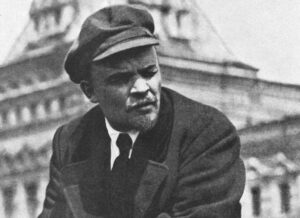
“It had deep roots in Maoist and other Stalinist groups at the time, which cultivated strong-arm youth cults,” he said. They emulated the Red Guards unleashed during the so-called Cultural Revolution in China to humiliate and crush political opponents of cult leader Mao Zedong. Terrorist groups were spawned, such as the Weathermen in the United States, the Red Army Faction in West Germany, Sendero Luminoso in Peru, and the Pol Potists in Kampuchea, all originating among and led by middle-class student youth and professionals.
Barnes recalled the blows dealt to workers’ struggles and union militants in coal mines and other industries in the 1970s by the ultraleft and thuggish conduct of Maoist groups such as the Revolutionary Communist Party and the Communist Workers Party. The CWP’s notoriously provocative “Death to the Klan” rally in North Carolina in November 1979 ended in the shooting deaths of five of its members and the wounding of several others. It did real damage to both the fights for Black liberation and defense of constitutional protections.
Barnes also pointed to the sensation at the time among Stalinists and other radicals of the “therapeutic violence” championed by psychiatrist Franz Fanon, whose writings are today being resurrected and cited to rationalize Hamas’ murders and sexual crimes. “Violence is a cleansing force,” wrote Fanon in The Wretched of the Earth. “It rids the colonized of their inferiority complex, of their passive and despairing attitude.”
The conduct of pro-Hamas demonstrators in the United States, United Kingdom, and elsewhere today is a product not of their youthful age, Barnes said. It is an intended consequence of the counterrevolutionary political course of leaders of various Stalinist parties and other historical political currents who attract and train these forces.
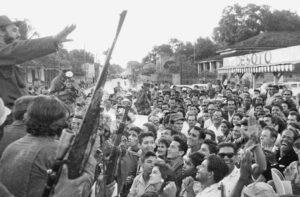
This is the opposite of the political course and proletarian morality of the communist leadership of Cuba’s socialist revolution, led by Fidel Castro. From the origins of the revolutionary struggle in the 1950s, Fidel insisted on the principle that no revolutionary leadership carries out actions “in which innocent people might be killed.”
Nor were enemy prisoners ever murdered, tortured, or left without medical care under Fidel’s leadership and command. “That was a matter of principle, of ethics, in our armed forces, one Fidel strictly demanded from the beginning of the revolutionary struggle,” said José Ramón Fernández, commander of the revolutionary forces that routed the U.S.-backed mercenary invasion at the Bay of Pigs in 1961 and later a general of Cuba’s Revolutionary Armed Forces and vice president of Cuba.
That principle is what led Fidel in 2008 to publicly condemn the course of the leadership of the Revolutionary Armed Forces of Colombia for taking civilians hostage and holding them, sometime for years, under harsh conditions. “These were objectively cruel actions,” Fidel wrote that year. “No revolutionary aim could justify them.”
How can the malignant ultraleftism and worship of violence among those hailing Hamas as national liberation fighters be pushed back and isolated? That will happen, Barnes said, as the class struggle expands and as unions and mass organizations of the oppressed become weightier in the leadership of these political battles. It will happen as the steadying hand of the working class and its communist vanguard comes to the fore in revolutionary struggles.
Building proletarian parties today
“The class composition of the party must correspond to its class program,” wrote Leon Trotsky in 1940. After Lenin’s death in early 1924, Trotsky led the worldwide political battle to continue the proletarian internationalist course of the communist movement reversed by the Stalinist counterrevolution in the Soviet Union and Communist International.
Since the mid-1930s, Barnes explained, Trotsky had waged a political effort in the new world movement he had helped launch to win its leaders to make a turn toward party-building mass work in the industrial working class and unions. Most of these parties at their origins were substantially middle class in composition. Trotsky’s primary ally in this political battle was the leadership of the Socialist Workers Party.
SWP cadres in those years had helped lead mass strikes and organizing drives in Minnesota and across the Midwest that brought hundreds of thousands of workers into the Teamsters union. They had set an example in organizing a union defense guard and mobilizations to combat anti-labor activity by nascent fascist groups. They explained in the unions and beyond the pressing need for a labor party independent of the bosses’ Democratic and Republican parties and of allied formations such as the Farmer-Labor Party in Minnesota. And they led the political campaign nationwide against the U.S. rulers’ drive to advance their class interests by entering the imperialists’ Second World War.
The Trotsky-led international struggle for a proletarian party reached a crisis point in late 1939, when a petty-bourgeois minority in the SWP National Committee — buckling to patriotic war pressures from the U.S. imperialist rulers — launched an attempt to throw overboard the party’s Marxist program, theoretical foundations and organizational norms. Trotsky advised SWP leaders that the party could politically defeat this fundamental challenge only by leading the entire party cadre and leadership more deeply into the working class and its class organizations. And that’s what they did.
The 1939-40 struggle in the SWP led by Trotsky, and the victory in that fight, Barnes said, are recorded in the book In Defense of Marxism, a new edition of which is being prepared by the party leadership to be published later this year.
That programmatic foundation, that struggle for a proletarian party has been led forward ever since. It’s the political course of the generations won to the Socialist Workers Party and its leadership in the 1960s and 1970s under the impact of the Cuban Revolution, the struggle to bring down Jim Crow segregation and the fight to end Washington’s war against the Vietnamese people. It remains the political course of the communist movement in the United States and internationally today.
It’s along that historic line of march, Barnes said, that a tested proletarian party will be forged in class battles, capable of organizing and leading the great working-class majority in the United States in a mass revolutionary movement that will decide which class will rule.
